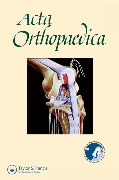
TKA: Similar pain outcomes for local infiltration anesthesia and continuous femoral block .
Pain control after total knee arthroplasty: a randomized trial comparing local infiltration anesthesia and continuous femoral block
Acta Orthop. 2011 Aug;82(4):441-7. Epub 2011 May 1140 patients undergoing total knee arthroplasty with spinal anaesthesia were randomized to receive either a local infiltration of anaesthesia or a continuous femoral block. The primary outcome was pain at rest and at movement. The results at 24 hours postoperatively indicated both interventions produced comparable analgesic effect. Local infiltration of anaesthesia may be preferred, because it is more cost-effective and easier to execute.
Unlock the Full ACE Report
You have access to 4 more FREE articles this month.
Click below to unlock and view this ACE Reports
Unlock Now
Critical appraisals of the latest, high-impact randomized controlled trials and systematic reviews in orthopaedics
Access to OrthoEvidence podcast content, including collaborations with the Journal of Bone and Joint Surgery, interviews with internationally recognized surgeons, and roundtable discussions on orthopaedic news and topics
Subscription to The Pulse, a twice-weekly evidence-based newsletter designed to help you make better clinical decisions
Exclusive access to original content articles, including in-house systematic reviews, and articles on health research methods and hot orthopaedic topics
































































